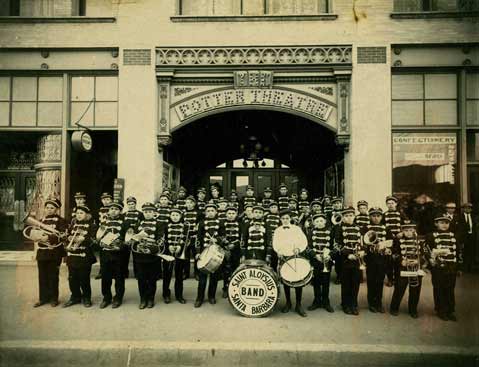‘I would like to know more about the Potter Theatre. Was it part of the Potter Hotel?’
-Howard Millward

The formal opening of the palatial Potter Hotel off of West Beach in 1903 was a major event for the city. Over the course of the next few years, this hotel would attract any number of wealthy wintering Easterners, who infused Santa Barbara’s tourist industry with a new vitality. An idea began to germinate that the town now needed a new, large, top-drawer venue to attract the very best theatrical touring groups.
For years that venue had been the theater opened by Jose Lobero in 1873. By the turn of the century, however, the theater, now known as the Santa Barbara Opera House, had fallen into a sad state of disrepair. Also, given the prejudices of the period, its location in Santa Barbara’s Chinatown was considered by many as less than ideal. Santa Barbara had other theaters, but they were too small to bring in the really big names in entertainment.
Discussion of building a new theater began as early as 1905, but it was not until the spring of 1906 that a group of local investors announced the creation of a company to fund construction. The building would cost some $75,000, and plans called for an edifice larger than Los Angeles’ famous Belasco Theater. Milo Potter, owner of the hotel that bore his name, agreed to buy the fireproof asbestos curtain for the theater if the owners named it the Potter Theatre. Construction soon began at the southwest corner of State and Montecito streets.
Originally, it was hoped that the theater would be completed by November 1906, but difficulties were encountered, one of which was the placement of a steel girder over the front of the stage. The girder weighed almost 6,800 pounds, and it became a daunting challenge to eventually maneuver it onto its resting place. There was also controversy when it was announced that the theater’s drop curtain would contain advertising, a fairly common practice at that time. Vain protests were raised in a number of quarters, including the Woman’s Club, that this would degrade what was supposed to be a first-class operation. The inclusion of a bar also spawned protests, again to no avail. The theater, of steel and brick, would seat 1,100 patrons. The best seats in the house cost $2.50.
The grand opening was set for the evening of January 29, 1907. Showing was the musical comedy, The Umpire, which at that time held the record for the longest run in Chicago theatrical history. It was advertised as perfect for “lovers of bright, clean, high-class entertainment.” Rainy weather prevented an opening night sellout, but those who did brave the elements came dressed to the nines. The streetcar company kept its Oak Park and Mission lines running late into the night for the convenience of theatergoers, many of whom capped off the evening at the Potter Hotel’s restaurant. After The Umpire closed, the next attraction was a vaudeville company that included a juggler named W.C. Fields.
The Potter soon established itself as the city’s state-of-the-art theater. Among those who stepped upon its stage over the years were actress Sarah Bernhardt, pianist Ignace Paderewski, dancer Ruth St. Denis, cellist Pablo Casals, and comedian Harry Lauder. The theater hosted operas, dramatic productions, symphonic concerts, vaudeville, and, beginning in 1916, motion pictures.
The Potter Theatre was destroyed in the earthquake of June 29, 1925. The second Lobero Theatre, which opened in 1924, would now take up the mantle of the premier venue for live entertainment in Santa Barbara



